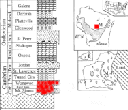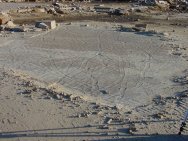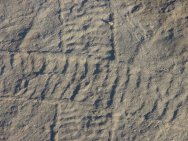Krukowski Quarry Black Berry Hill
Black Berry HillCambrian Trace Fossil Trackways and Ichnofossils from the Krukowski Quarry of Central WisconsinFirst Footprints on Land |
Also
see: |
Scyphozoan Medusae (jellyfish) Fossils Climactichnites Arthropods - Protichnites and Diplichnites Stromatolites
Scyphozoan Medusae (jellyfish) FossilsAmong
the fossils and trace fossils found in this quarry are numerous
circular impressions in layers of rippled sandstone where there
once was a shallow tropical seashore during the
Cambrian.
Hagadorn,
et. al. describe an exceedingly rare event, the largest mass
stranding in the fossil record of Cnidarian medusae (Class Scyphozoa
– jellyfish). Hagadorn,
et. al. state that the quarry's features are "consistent
with an intermittently exposed intertidal and shallow-subtidal
setting that was probably located in a shallow lagoonal area
with limited wind fetch . . . . within a possible sandy barrier
island system on the flank of the Wisconsin dome may have further
restricted the environment, and severe Far more rare in the quarry are bedding planes with small jellyfish fossils that like their large medusoid counterparts exhibit evidence of struggling subsequent to mass standing and prior to their demise. Additionally, some of these markedly smaller jellyfish fossils reveal subtle impressions of tentacles in the familiar radial symmetry of Cnidarians. These fossils are not yet described in the peer-reviewed literature. Climactichnites
In his recent thesis, Getty (2007) has revisited the vexing enigma of Climactichnites bases on new knowledge of the role of microbial mats in Cambrian sediments. Specifically, microbial mats may have been abundant through the Cambrian, mediating the preservation of Climactichnites (and other foosils of the Krukowski quarry), but were no longer prevalent from the Ordovician, where Climactichnites are no longer appears. Experiments confirmed that the trackways are similar to those formed by modern gastropods. If so, the uniqueness of Climactichnites is in its preservation, not its origins. Climactichnites from the quarry are found in association with sand stromatolites. Ichnofossil preservation was thus was possibly aided by a microbial mat which bound the substrate and resisted bioturbation. Getty concludes that the the Climactichnites trackmaker was an "elongate, bilaterally symmetric, dorsoventrally flattened, soft-footed animal with a muscular anterior used during locomotion". Most of the animals were between 1.4 and 18 cm wide and 3.2 to 41 cm long, though one trackway measured some 29 cm wide, implying an animal 67 cm long. The ventral surface of the animal may have had glands that secreted mucus during track formation, and the dorsal surface may have been naked or may have borne sclerites. The trackmaker may have made some trackways in subaerial conditions and, if so, Climactichnites may mean that a mollusks may be included with arthropods as first terrestrial pioneers. Arthropods - Protichnites and Diplichnites TrackwaysThe most exciting fossils of the Krukowski quarry are trackway ichnofossils of amphibious arthropods - creatures making the first footprints on land. Both Protichnites and Diplichnites ichnogenera are prominently represented. A number of sedimentary features, adhesion surfaces, large ripples, and raindrop imprints support the hypothesis that subaerial exposure occurred at or near the time the tracks were made, and that the arthropods had voluntarily ventured out of the water. What creatures made the prints and what were they doing out of the water? The discovery of arthropod body fossils in 2003 (not yet published) provides clues. These arthropod fossils contained in dessication zones are not so well articulated, but suggest multi-legged telson-bearing creatures having morphological characteristics of Aglaspid or Euthycarcinoid origins. Prior to discovery of the arthropod fossils, both horseshoe crabs and eurypterids were suggested as the Protichnites track makers of the quarry. The Diplichnites exhibit only foot prints, and lack the telson drag marks. This does not rule out telson bearing creatures made Diplichnites, but does suggest other trackmakers such as such as a primitive marine Myriapod-like creatures may have been present. Though rare, ichnogenus Rusophycus has been found in the quarry. Rusophycus was placed in the ichnogenus Cruziana by Seilacher in 1970, but the term is still widely used by ichnologists for a putative resting place rather than trackway of a trilobite or other arthropod. StromatolitesMicrobial sedimentary structures are abundant in the Krukowski quarry and are often found in association with the other fossils. These include elephant skin, sand peloids (i.e., bacterially mediated precipitation), domal sand stromatolites, and sand chips. Such structures may underlie and overlie medusae stranding surfaces, and mats of these microbes may well have been the principle reason the ichnofossils were not destroyed by wave action, erosion, and bioturbation. |
|
||||||
|
Fossil
Museum Navigation:
Home Geological Time Paleobiology Geological History Tree of Life Fossil Sites Fossils Evolution Fossil Record Museum Fossils |




